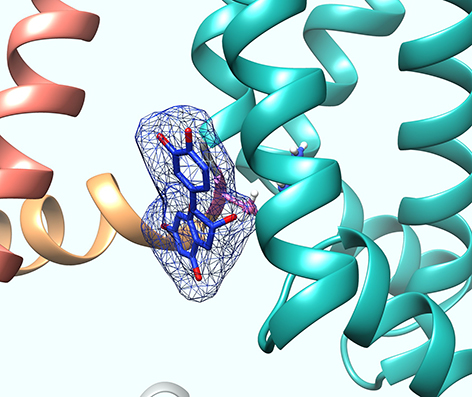Published in Cellular Physiology and Biochemistry, the discovery was made by the laboratory of Geoffrey Abbott, PhD, a professor in the Department of Physiology and Biophysics at the UCI School of Medicine. Kaitlyn Redford, a graduate student in the Abbott Lab, was first author of the study titled, “KCNQ5 potassium channel activation underlies vasodilation by tea.”
Results from the research revealed that two catechin-type flavonoid compounds (epicatechin gallate and epigallocatechin-3-gallate) found in tea, each activate a specific type of ion channel protein named KCNQ5, which allows potassium ions to diffuse out of cells to reduce cellular excitability. As KCNQ5 is found in the smooth muscle that lines blood vessels, its activation by tea catechins was also predicted to relax blood vessels – a prediction confirmed by collaborators at the University of Copenhagen.
“We found by using computer modeling and mutagenesis studies that specific catechins bind to the foot of the voltage sensor, which is the part of KCNQ5 that allows the channel to open in response to cellular excitation. This binding allows the channel to open much more easily and earlier in the cellular excitation process,” explained Abbott.
Because as many as one third of the world’s adult population have hypertension, and this condition is considered to be the number one modifiable risk factor for global cardiovascular disease and premature mortality, new approaches to treating hypertension have enormous potential to improve global public health. Prior studies demonstrated that consumption of green or black tea can reduce blood pressure by a small but consistent amount, and catechins were previously found to contribute to this property. Identification of KCNQ5 as a novel target for the hypertensive properties of tea catechins may facilitate medicinal chemistry optimization for improved potency or efficacy.
In addition to its role in controlling vascular tone, KCNQ5 is expressed in various parts of the brain, where it regulates electrical activity and signaling between neurons. Pathogenic KCNQ5 gene variants exist that impair its channel function and in doing so cause epileptic encephalopathy, a developmental disorder that is severely debilitating and causes frequent seizures. Because catechins can cross the blood-brain barrier, discovery of their ability to activate KCNQ5 may suggest a future mechanism to fix broken KCNQ5 channels to ameliorate brain excitability disorders stemming from their dysfunction.
Tea has been produced and consumed for more than 4,000 years and upwards of 2 billion cups of tea are currently drunk each day worldwide, second only to water in terms of the volume consumed by people globally. The three commonly consumed caffeinated teas (green, oolong, and black) are all produced from the leaves of the evergreen species Camellia sinensis, the differences arising from different degrees of fermentation during tea production.
Black tea is commonly mixed with milk before it is consumed in countries including the United Kingdom and the United States. The researchers in the present study found that when black tea was directly applied to cells containing the KCNQ5 channel, the addition of milk prevented the beneficial KCNQ5-activating effects of tea. However, according to Abbott, “We don’t believe this means one needs to avoid milk when drinking tea to take advantage of the beneficial properties of tea. We are confident that the environment in the human stomach will separate the catechins from the proteins and other molecules in milk that would otherwise block catechins’ beneficial effects.”
This hypothesis is borne out by other studies showing antihypertensive benefits of tea regardless of milk co-consumption. The team also found, using mass spectrometry, that warming green tea to 35 degrees Celsius alters its chemical composition in a way that renders it more effective at activating KCNQ5.
“Regardless of whether tea is consumed iced or hot, this temperature is achieved after tea is drunk, as human body temperature is about 37 degrees Celsius,” explained Abbott. “Thus, simply by drinking tea we activate its beneficial, antihypertensive properties.”
This study was supported in part by the National Institutes of Health, National Institute of General Medical Sciences, National Institute of Neurological Disorders and Stroke, the Lundbeck Foundation and the Danmarks Frie Forskningsfond.
About the UCI School of Medicine
Each year, the UCI School of Medicine educates more than 400 medical students, and nearly 150 doctoral and master’s students. More than 700 residents and fellows are trained at UCI Medical Center and affiliated institutions. The School of Medicine offers an MD; a dual MD/PhD medical scientist training program; and PhDs and master’s degrees in anatomy and neurobiology, biomedical sciences, genetic counseling, epidemiology, environmental health sciences, pathology, pharmacology, physiology and biophysics, and translational sciences. Medical students also may pursue an MD/MBA, an MD/master’s in public health, or an MD/master’s degree through one of three mission-based programs: the Health Education to Advance Leaders in Integrative Medicine (HEAL-IM), the Leadership Education to Advance Diversity-African, Black and Caribbean (LEAD-ABC), and the Program in Medical Education for the Latino Community (PRIME-LC). The UCI School of Medicine is accredited by the Liaison Committee on Medical Accreditation and ranks among the top 50 nationwide for research. For more information, visit som.uci.edu.
###


